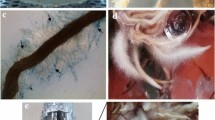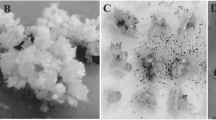Abstract
Thlaspi caerulescens L. is well known as a Zn/Cd hyperaccumulator. The genetic manipulation of T. caerulescens through transgenic technology can modify plant features for use in phytoremediation. Here, we describe the efficient transformation of T. caerulescens using Agrobacterium tumefaciens strain EHA105 harboring a binary vector pBI121 with the nptII gene as a selectable marker, the gus gene as a reporter and a foreign catalase gene. Based on the optimal concentration of growth regulators, the shoot cluster regeneration system via callus phase provided the basis of the genetic transformation in T. caerulescens. The key variables in transformation were examined, such as co-cultivation period and bacterial suspension density. Optimizing factors for T-DNA delivery resulted in kanamycin-resistant transgenic shoots with transformation efficiency more than 20%, proven by histochemical GUS assay and PCR analysis. Southern analysis of nptII and RT-PCR of catalase gene demonstrated that the foreign genes were integrated in the genome of transformed plantlets. Moreover, the activity of catalase enzyme in transgenic plants was obviously higher than in wild-type plants. This method offers new prospects for the genetic engineering of this important hyperaccumulator species.










Similar content being viewed by others
Abbreviations
- KT:
-
Kinetin
- BA:
-
Benzylaminopurine
- NAA:
-
α-Naphthaleneacetic acid
- AS:
-
Acetosyringone
- LH:
-
Lactalbumin hydrolysate
- GA3 :
-
Gibberellin
- BCM:
-
Basic culture medium
- RCM:
-
Regeneration culture medium
- PCM:
-
Pre-culture medium
- CCM:
-
Co-cultivation medium
- SCM-Cb:
-
Selection culture medium with carbenicillin
- SCM-Km:
-
Selection culture medium with carbenicillin and kanamycin
- SCM-GA3 :
-
Selection culture medium with GA3
- RM-Km:
-
Rooting medium with kanamycin
References
Assunção, G. L. A., Schat, H., & Aarts, M. G. M. (2003). Thlaspi caerulescens, an attractive model species to study heavy metal hyperaccumulation in plants. New Phytologist, 159, 351–360.
Alkorta, I., Hernández-Allica, J., Becerril, J. M., Amezaga, I., Albizu, I., & Garbisu, C. (2004). Recent findings on the phytoremediation of soils contaminated with environmentally toxic heavy metals and metalloids such as zinc, cadmium, lead, and arsenic. Reviews in Environmental Science and Bio/technology, 3, 71–90.
Garbisu, C., & Alkorta, I. (2001). Phytoextraction: A cost-effective plant-based technology for the removal of metals from the environment. Bioresource Technology, 77, 229–236.
Weber, O., Scholz, R. W., Bühlamann, R., & Crasmüch, D. (2001). Risk perception of heavy metal soil contamination and attitudes toward decontamination strategies. Risk Analysis, 21, 967–977.
Datta, R., & Sarkar, D. (2004). Effective integration of soil chemistry and plant molecular biology in phytoremediation of metals: An overview. Environmental Geosciences, 11(2), 53–63.
Krämer, U. (2005). Phytoremediation: novel approaches to cleaning up polluted soils. Current Opinion in Biotechnology, 16, 133–141.
Flowers, T. J., & Yeo, A. R. (1995). Breeding for salinity resistance in crop plants: Where next? Australian Journal of Plant Physiology, 22, 875–884.
Garbisu, C., Hernández-Allica, J., Barrutia, O., Alkorta, I., & Becerril, J. M. (2002). Phytoremediation: A technology using green plants to remove contaminants from polluted areas. Reviews on Environmental Health, 17, 75–90.
Azpilicueta, C. E., Benavides, M. P., Tomaro, M. L., & Gallego, S. M. (2007). Mechanism of CATA3 induction by cadmium in sunflower leaves. Plant Physiology and Biochemistry, 45, 589–595.
Lee, M. Y., & Shin, H. W. (2003). Cadmium-induced changes in antioxidant enzymes from the marine alga Nannochloropsis oculata. Journal of Applied Phycology, 15, 13–19.
Gelvin, S. B. (2003). Agrobacterium-mediated plant transformation: The biology behind the “Gene-Jockeying” tool. Microbiology and Molecular Biology Review, 67(1), 16–37.
Peer, W. A., Mamoudian, M., Lahner, B., Reeves, R. D., Murphy, A. S., & Salt, D. E. (2003). Identifying model metal hyperaccumulating plants: Germplasm analysis of 20 Brassicaceae accessions from a wide geographical area. New Phytologist, 159, 421–430.
Lang, M., Zhang, Y., & Chai, T. (2005). Identification of genes up-regulated in response to Cd exposure in Brassica juncea L. Gene, 363, 151–158.
Hood, E. E., Gevin, S. B., Melchers, L. S., & Hoekema, A. (1993). New Agrobacterium vectors for plant transformation. Transgenic Research, 2, 208–218.
Zhang, Y. X., Xu, J., Han, L., Wei, W., Guan, Z. Q., Cong, L., & Chai, T. Y. (2006). Efficient shoot regeneration and Agrobacterium-mediated transformation of Brassica juncea. Plant Molecular Biology Reporter, 24, 255a–255i.
Jefferson, R. A., Kavanagh, T. A., & Bevan, M. W. (1987). GUS fusions: β-Glucuronidase as a sensitive and versatile gene fusion marker in higher plants. The EMBO Journal, 6(13), 3901–3907.
Doyle, J. J., & Doyle, J. L. (1987). A rapid DNA isolation procedure for small quantities of fresh leaf tissue. Phytochemical Bulletin, 19, 11–15.
Bradford, M. M. (1976). A rapid sensitive method for the quantification of microgram quantities of protein utilising the principle of protein-Dye Binding. Analytical Biochemistry, 72, 248–254.
Sinha, A. K. (1972). Colorimetric assay of catalase. Analytical Biochemistry, 47, 389–394.
Plaza, S., Tearall, K. L., Zhao, F. J., Buchner, P., McGrath, S. P., & Hawkesford, M. J. (2007). Expression and functional analysis of metal transporter genes in two contrasting ecotypes of the hyperaccumulator Thlaspi caerulescens. Journal of Experimental Botany, 58(7), 1717–1728.
Colman, A. (1990). Antisense strategies in cell and developmental biology. Journal of Cell Science, 97, 399–409.
Trigiano, R. N., & Gray, D. J. (1999). Plant tissue culture concepts and laboratory exercises (2nd ed.). London: CRC press.
Ahmadabadi, M., Ruf, S., & Bock, R. (2007). A leaf-based regeneration and transformation system for maize (Zea mays L.). Transgenic Research, 16, 437–448.
Chaudhury, D., Madanpotra, S., Jaiwal, R., Saini, R., Ananda Kumar, P., & Jaiwal, P. K. (2007). Agrobacterium tumefaciens-mediated high frequency genetic transformation of an Indian cowpea (Vigna unguiculata L. Walp.) cultivar and transmission of transgenes into progeny. Plant Science, 172, 692–700.
Saini, R., & Jaiwal, P. K. (2005). Efficient transformation of a recalcitrant grain legume Vigna mungo L. Hepper via Agrobacterium-mediated gene transfer into shoot apical meristem cultures. Plant Cell Reports, 24, 164–171.
Shiv Prakash, N., Pental, D., Bhalla-Sarin, N. (1997). Regeneration of pigeonpea (Cajanus cajan) from cotyledonary node via multiple shoot formation. Plant Cell Reports, 13, 623–627.
Santalla, M., Power, J. B., Davey, M. R. (1998). Efficient in vitro shoot regeneration responses of Phaseolus vulgaris and P. coccineus. Euphytica, 102, 195–202.
Al-Ramamneh, E. A., Sriskandarajah, S., & Serek, M. (2006). Agrobaterium tumefaciens-mediated transformation of Rhipsalidopsis gaertneri. Plant Cell Reports, 25, 1219–1225.
Kumria, R., Waie, B., & Rajam, M. V. (2001). Plant regeneration from transformed embryogenic callus of an elite indica rice via Agrobacterium. Plant Cell Tissue Organ Culture, 67, 63–71.
Romero-Puertas, M. C., Rodríguez-Serrano, M., Corpas, F. J., Gómez, M., Delrío, L. A., & Sandalio, L. M. (2004). Cadmium-induced subcellular accumulation of O •−2 and H2O2 in pea leaves. Plant Cell & Environment, 27, 1122–1134.
Tseng, M. J., Liu, C. W., & Yiu, J. C. (2007). Enhanced tolerance to sulfur dioxide and salt stress of transgenic Chinese cabbage plants expressing both superoxide dismutase and catalase in chloroplasts. Plant Physiology and Biochemistry, 45, 822–833.
Acknowledgments
The research was supported by the National High Technology Planning Program of China (Grant nos. 2006AA10Z407 and 2007AA021404) and China National Natural Sciences Foundation (Grant no. 30570146).
Author information
Authors and Affiliations
Corresponding author
Rights and permissions
About this article
Cite this article
Guan, Z.Q., Chai, T.Y., Zhang, Y.X. et al. Gene Manipulation of a Heavy Metal Hyperaccumulator Species Thlaspi caerulescens L. via Agrobacterium-mediated Transformation. Mol Biotechnol 40, 77–86 (2008). https://doi.org/10.1007/s12033-008-9065-4
Received:
Accepted:
Published:
Issue Date:
DOI: https://doi.org/10.1007/s12033-008-9065-4




